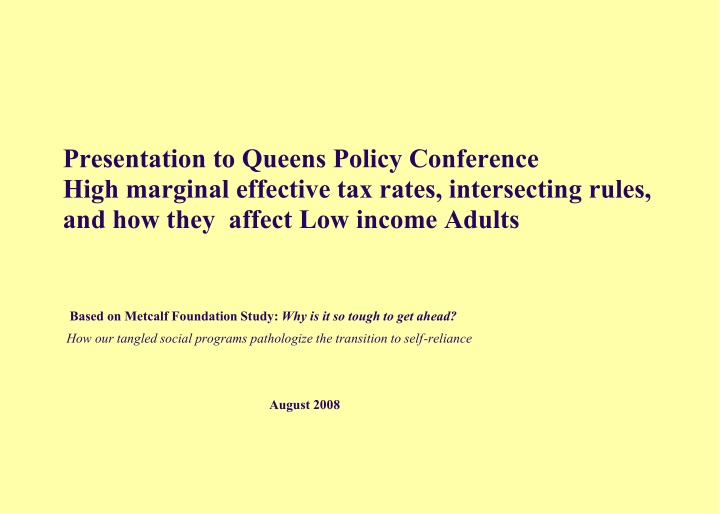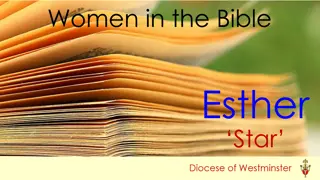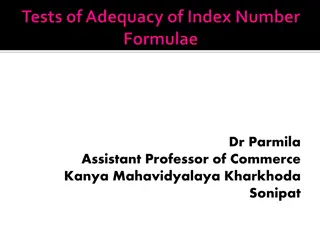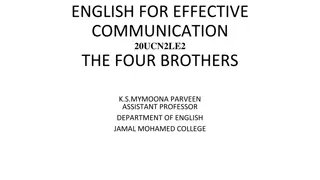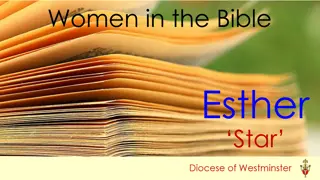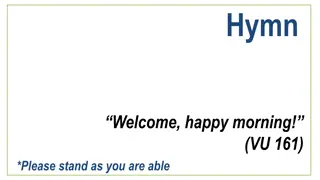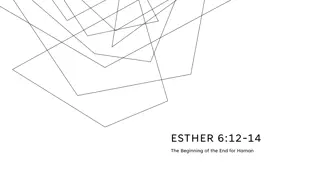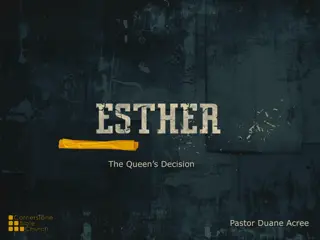Esther: The Great Reversal and Triumph
Esther's transformation from hiding her Jewish identity to boldly claiming it, the rise of Mordecai, and the victory of the Jews against their enemies in a story of courage, faith, and divine providence.
Download Presentation

Please find below an Image/Link to download the presentation.
The content on the website is provided AS IS for your information and personal use only. It may not be sold, licensed, or shared on other websites without obtaining consent from the author.If you encounter any issues during the download, it is possible that the publisher has removed the file from their server.
You are allowed to download the files provided on this website for personal or commercial use, subject to the condition that they are used lawfully. All files are the property of their respective owners.
The content on the website is provided AS IS for your information and personal use only. It may not be sold, licensed, or shared on other websites without obtaining consent from the author.
E N D
Presentation Transcript
Presentation to Queens Policy Conference High marginal effective tax rates, intersecting rules, and how they affect Low income Adults Based on Metcalf Foundation Study: Why is it so tough to get ahead? How our tangled social programs pathologize the transition to self-reliance August 2008
Growth in Number of Working Age Adults in 39 Richest OECD Countries (Source: OECD) 1950 - 2000: 76% 2000 - 2050: 4% (projected) This one fact changes everything . 2
Presentation Overview: Programs, People and Expenditures Metcalf Foundation Study: Why is it so tough to get ahead? The Story of Ali Issue 1: High Marginal Effective Tax Rates Issue 2: Navigating the Maze Issue 3: The false imposition of adulthood Issue 4: The failure of welfare solutions Further recommendations for reform
Canada Ranks 25th of 30 OECD Countries in Social Spending on Working Age Population Income support to the working-age population Public social expenditure Total CASH Total SERVICES Sweden (31.3) France (28.7) Germany (27.6) Denmark (27.6) Belgium (26.5) Austria (26.1) Norway (25.1) Italy (24.2) Portugal (23.5) Poland (22.9) Hungary (22.7) Finland (22.5) Luxembourg (22.2) Greece (21.3) Czech Rep. (21.1) Netherlands (20.7) OECD-30 (20.7) Switzerland (20.5) Spain (20.3) United Kingdom (20.1) Iceland (18.7) New Zealand (18) Australia (17.9) Japan (17.7) Slovak Rep. (17.3) Canada (17.3) United States (16.2) Ireland (15.9) Turkey (13.2) Mexico (6.8) Korea (5.7) 8.0 6.2 4.8 9.5 7.3 6.1 7.8 2.8 4.5 5.2 5.8 7.0 7.8 2.2 5.0 6.8 5.0 5.1 5.1 5.6 4.4 6.2 5.3 1.5 4.4 3.0 2.2 5.6 2.6 0.6 0.9 31.3 28.7 27.6 27.6 26.5 26.1 25.1 24.2 23.5 22.9 22.7 22.5 22.2 21.3 21.1 20.7 20.7 20.5 20.3 20.1 18.7 18.0 17.9 17.7 17.3 17.3 16.2 15.9 13.2 6.8 5.7 16.1 18.2 16.3 14.8 16.4 18.9 13.1 16.5 14.7 17.6 13.8 12.5 14.2 14.5 12.6 11.9 12.1 12.0 13.3 11.2 6.8 10.7 8.8 9.7 10.8 7.4 8.4 9.0 8.9 1.9 2.3 13.9 9.5 10.2 11.2 8.8 6.5 11.2 7.0 8.1 5.1 8.5 9.1 7.8 6.6 8.4 7.7 8.0 7.8 6.3 8.5 11.8 6.9 8.7 7.7 6.2 9.5 7.7 6.3 4.1 4.9 3.3
CANADA: INCOME SECURITY EXPENDITURES BY PROGRAM 2005-06 ($112.7 B est) Other 2% Property/Sales Tax Credits, Rental Assistance 3% Workers Compensation 6% OAS/GIS/Allowance 27% Social Assistance 10% Veterans 1% EI 11% GST Credit 3% CCTB 8% CPP/QPP 29%
CANADA: INCOME SECURITY SPENDING BY TARGET RECIPIENT CANADA 2005-06 ($112.7 B est) Other 11% Social Assistance recipients 4% EI recipients 11% Seniors 47% Disabled 16% Children 11%
Income Security is Primarily Under Federal Control Ontario Example Percent of Income Security Program Spending in Ontario in 2005/06 ($41.5 Billion1,2 = 100%) Munic. Prov. 2% 10% 18% By Order Of Government2 80% Federal (1) (2) Doesn t include the Canada Social Transfer from the Federal government to Ontario Includes contributory programs (EI-and Workers Compensation) 7
Metcalf Foundation Study Approached Three Communities in Toronto .. Somali community in North Rexdale poverty enclave. Chinese-Vietnamese community in Downsview poverty enclave. St. Christopher House Community Reference Group Gentrifying community Most receiving OW or ODSP, live in subsidized housing, many aged out of Child Welfare system or lived in refugee camps abroad. Discover their problems in their words translate their words into policy-ready recommendations. 8
Report comes out of Modernizing Income Security for Working-Age Adults Original Issue presented as a barrier: Discovery that young adults in subsidized housing are discouraged by parents to enrol in work-study courses as their income would go down . True story: 18+ students considered to be dependent adults . If they go from full time to part time, their part time earnings deducted at 50% from parents ODSP or OW income also can result in rent increases. 9 9
The Story of Ali A Closer Look Ali lived in subsidized housing with parents receiving Ontario social assistance father a person with disabilities o Takes part time job at age 17 ($600 net per month) no income recovery except EI, CPP Turns 18: Accepted to University applies for student aid (OSAP) o o o o o o o Parents lose child benefits ($150 or so) $300 (50%) of his net earnings deducted from parents social assistance Subsidized rent increases by $75 (METR now at 70%) Student Aid (OSAP) assesses student based on gross earnings Loss leads to choice to move out of the parental home as couch rider Away from home, can only attend university part time o o o Student aid declines with part time status
Alis case: A closer look Parents social assistance rises by $300 and rent reduces by $75 a month Ali now unknown to the system and cannot reveal that he lives in a friend s apartment or rent would go up, public assistance down just like living with parents Ali learns of work/study program available to young adults living in subsidized housing must turn it down or reveal himself to the system. o o o Couch riding not conducive to studies quits university in favour of saving for studies to be undertaken later on o Six Months later: Ali gets notice to repay his student aid at prevailing interest rates o o o Parents get notice of eviction as Ali moving out results in them being judged to be overhoused Ali quits job moves back in with parents; apartment reinstated; can t pay student aid, defaults, loses credit cards and credit rating Ali begins again o o
Issue 1: High Marginal Effective Tax Rates (METRs) METRs are caused by the way government departments are organized and by the METRs themselves. Social Assistance recovers 50% (starts at first dollar) Subsidized housing charges 15 to 30% (starts at first dollar) EI 1.4% (starts at first dollar) CPP 4.95% (starts at $4500) Lowest Federal Tax Rate 15% (starts at $9600) 12
Issue: The Current Process - confusing, difficult and conflicting Undocumented program interaction (e.g., overall result of earnings on welfare and housing). Unavailability of program rules (e.g., OSAP). Collection of information that is not used for any purpose (e.g. Housing insists on reporting of Child Benefits yet not counted in rent). Shock & Awe notifications for minor infractions (e.g., termination and eviction notices in OW and housing). Byzantine sets of rules: (e.g., Toronto Community Housing Corporation, 213 page manual on calculation of rents geared to income). http://www.toronto.ca/housing/social_housing/rgi/rgi-guide-july2005revision.pdf Immediate terminations and reductions followed by glacial period for reinstatement of benefits. 13
Recommendation: METRs Reduce METRs Ensure that combined, METRs do not exceed 75% of net earned income. 14 14
Recommendation: A TIME OUT We can't "solve" high METRs, but we can take a "time out" at crucial times to allow young people to break the cycle of poverty. e.g. Suspend rent increases and OW payment reductions. 15 15
Issue 2: More Than One Maze to Navigate Navigating the maze is a common expression For low income people: The mazes are larger and there are many more to navigate. Navigation advice is non-existent or poor. 16 16
Recommendation: Government Structure Create a government responsibility centre - i.e. A permanent Cabinet Committee not unlike the Cabinet Committee on poverty - Supported by Deputies and Directors Responsibility Centre 17
Recommendation: Government Structure Through a Responsibility Centre, share and pool data. The Responsibility Centre should consult with civil society, agencies, and activists questioning the business model of governance. 18
Recommendation: Improve Service Navigation for Clients Create transition-friendly programs that strive towards common definitions. Improve the quality of advice on program interactions. 19
Issue 3: Children in Their Transition to Adulthood An underclass is second generation poverty . As children become adults, programs produce upheaval, thwarting efforts to break the cycle. 20 20
Underclass and the Myth of Adulthood At 18, children are independent. This myth has been rejected by every reasonable parent living in Canada. Governments often enforce adulthood at age 18. 21 21
Recommendation: Support Children in Their Transition to Adulthood Redefine adulthood: Don t take on adult status while in post-secondary education, up to age 24. Suspend rental increases where student income is included in the calculation including: Any non-government funded scholarship, award, or grant from a recognized educational institution; and Any award, scholarship or grant received from a non-government group (such as a Children s Aid Society, charitable organization, or company). Stop collecting information on student assistance from government sources. Clear up misunderstandings about receiving OSAP resulting in rent penalties. 22
Issue 4: Policy and Welfare People should only access the mainstream after they have left welfare - the logic of "making the leap". 23 23
How society views welfare Welfare will continue to erode to inflation, because the system rejects many of society s fundamental values. 24 24
The Importance of a Different Lens Behaviour Welfare cheat lens Achieving self-sufficiency lens She s got a boyfriend Forming a viable economic and family unit to escape poverty Acquiring a spouse Getting illicit money Reinforces role of families helping their own members helping build a base to escape poverty Help from family Hiding money from the system Returning to normalcy building assets demonstrating money management skills building a base to escape poverty Having a bank account being seen in a bank Working and not reporting it - working under the table The first major building block in becoming self-sufficient and returning to normalcy and self-sufficiency Getting a job How can they afford that if they are supposed to be poor? Returning to normalcy taking responsibility for a household budget making choices for better or worse weighing risk and responsibility consistent with adult behaviour Spending on non- necessities 25 25
Other Policy Recommendations Short term Raise assets limits for all social assistance recipients with an approved employment plan for the purpose of financing sustained employment. Stabilize households in transition to greater self reliance. Establish a transition planning system among Ministries. Grant a 1 year renewable moratorium on rent increases, OW reductions, losses in child care subsidies and student assistance. Longer term Raise asset levels for OW recipients to $5500 single and $9000 for families. Use the TFSA vehicle to help 26 Devise a public education initiative to resolve misperceptions.
